heating BMW 330CI COUPE 2004 E46 Owner's Manual
[x] Cancel search | Manufacturer: BMW, Model Year: 2004, Model line: 330CI COUPE, Model: BMW 330CI COUPE 2004 E46Pages: 174, PDF Size: 2.73 MB
Page 8 of 174

Contents
Notes
About this Owner's Manual4
Additional sources of
information4
Symbols used4
Your individual vehicle5
Status at time of printing5
For your own safety5
Service and warranty6
Reporting safety defects7
Overview
Cockpit14
Instrument cluster16
Indicator and warning lamps18
Buttons in steering wheel*21
Hazard warning triangle*22
First-aid kit*22
Refueling23
Fuel specifications24
Controls and features
Opening and closing:
Keys28
Central locking system28
Opening and closing – via the
remote control29
Opening and closing – via the
door lock31
Opening and closing – from the
inside32
Luggage compartment lid33
Luggage compartment35
Alarm system*36
Electric power windows38
Glass sunroof, electric*39
Adjustments:
Safe seating position41
Seats42
Manual seat adjustment42
Power seat adjustment*44
Lumbar support*44
Head restraints45
Entering the rear45
Safety belts46
Seat and mirror memory*47
Seat heating*48
Mirrors49
Steering wheel50
Page 18 of 174

18
Indicator and warning lamps
Technology that monitors itself
Indicator and warning lamps that are
identified by
●
are tested for proper
functioning whenever the ignition key is
turned. They each light up once for dif-
ferent periods of time.
If a fault should occur in one of these
systems, the corresponding lamp does
not go out after the engine is started, or
it lights up while the vehicle is moving.
You will see how to react to this below.
Red: stop immediately
Battery charge current
●
The battery is no longer being
charged. Indicates a defective
alternator drive belt or a problem with
the alternator's charge circuit. please
contact the nearest BMW center.
If the drive belt is defective, stop
and switch off the engine immedi-
ately to prevent overheating and seri-
ous engine damage. If the drive belt is
defective, increased steering effort is
also required.
<
Engine oil pressure
●
The engine oil pressure is too
low. Stop the vehicle immedi-
ately and switch off the engine. It is not
possible to continue driving. Please
contact the nearest BMW center.
Do not continue driving, as the
engine could sustain serious dam-
age from inadequate lubrication.
<
Brake warning lamp
●
If the lamp comes on when the
parking brake is not engaged:
check the brake fluid level. It is very
important that you follow the instruc-
tions on page 128 before driving on.
Have the system checked immediately.
Brake warning lamp for Cana-
dian models.
Flat Tire Monitor
●
In addition, an acoustic signal is
sounded: there is a flat tire.
Reduce speed and carefully come to a
stop. Avoid sudden braking and steer-
ing maneuvers.
For additional information, refer to
page 83.
Red and yellow: continue driving
cautiously
The brake warning lamp comes
on together with the yellow indi-
cator lamps for ABS
●
and
DSC:
The entire ABS, CBC and DSC
control system has failed. Con-
tinue driving cautiously and
defensively. Avoid hard brake
applications. Please have the system
checked by your BMW center as soon
as possible.
Additional information beginning on 81.
CBC, ABS and DSC and DBC
indicator and warning lamps for
Canadian models.
Red: an important reminder
Brake warning lamp
Comes on when the parking
brake is applied – an additional
acoustic signal sounds when starting
off.
For additional information, refer to
page 61.
Page 48 of 174
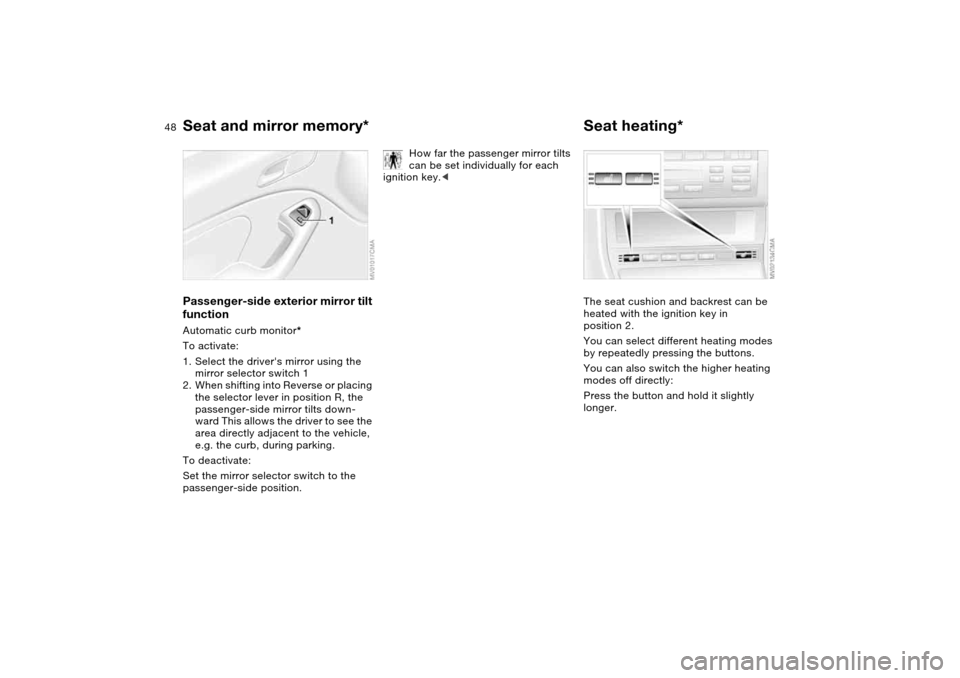
48
Passenger-side exterior mirror tilt
functionAutomatic curb monitor*
To activate:
1. Select the driver's mirror using the
mirror selector switch 1
2. When shifting into Reverse or placing
the selector lever in position R, the
passenger-side mirror tilts down-
ward This allows the driver to see the
area directly adjacent to the vehicle,
e.g. the curb, during parking.
To deactivate:
Set the mirror selector switch to the
passenger-side position.
How far the passenger mirror tilts
can be set individually for each
ignition key.<
Seat heating*The seat cushion and backrest can be
heated with the ignition key in
position 2.
You can select different heating modes
by repeatedly pressing the buttons.
You can also switch the higher heating
modes off directly:
Press the button and hold it slightly
longer.
Seat and mirror memory*
Page 92 of 174
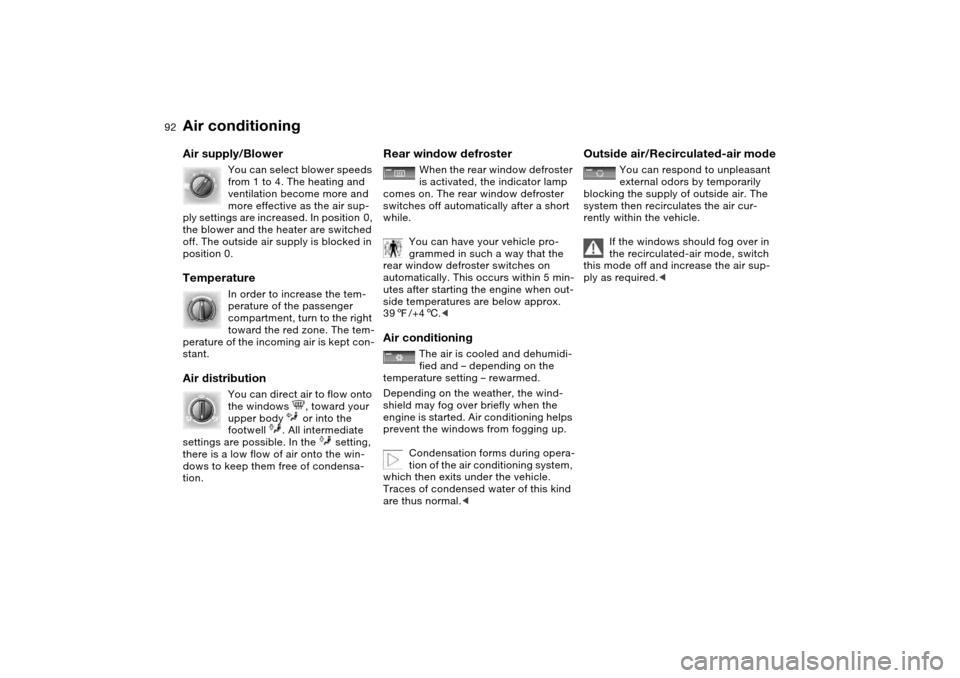
92
Air supply/Blower
You can select blower speeds
from 1 to 4. The heating and
ventilation become more and
more effective as the air sup-
ply settings are increased. In position 0,
the blower and the heater are switched
off. The outside air supply is blocked in
position 0.
Temperature
In order to increase the tem-
perature of the passenger
compartment, turn to the right
toward the red zone. The tem-
perature of the incoming air is kept con-
stant.
Air distribution
You can direct air to flow onto
the windows , toward your
upper body or into the
footwell . All intermediate
settings are possible. In the setting,
there is a low flow of air onto the win-
dows to keep them free of condensa-
tion.
Rear window defroster
When the rear window defroster
is activated, the indicator lamp
comes on. The rear window defroster
switches off automatically after a short
while.
You can have your vehicle pro-
grammed in such a way that the
rear window defroster switches on
automatically. This occurs within 5 min-
utes after starting the engine when out-
side temperatures are below approx.
397/+46.<
Air conditioning
The air is cooled and dehumidi-
fied and – depending on the
temperature setting – rewarmed.
Depending on the weather, the wind-
shield may fog over briefly when the
engine is started. Air conditioning helps
prevent the windows from fogging up.
Condensation forms during opera-
tion of the air conditioning system,
which then exits under the vehicle.
Traces of condensed water of this kind
are thus normal.<
Outside air/Recirculated-air mode
You can respond to unpleasant
external odors by temporarily
blocking the supply of outside air. The
system then recirculates the air cur-
rently within the vehicle.
If the windows should fog over in
the recirculated-air mode, switch
this mode off and increase the air sup-
ply as required.<
Air conditioning
Page 96 of 174
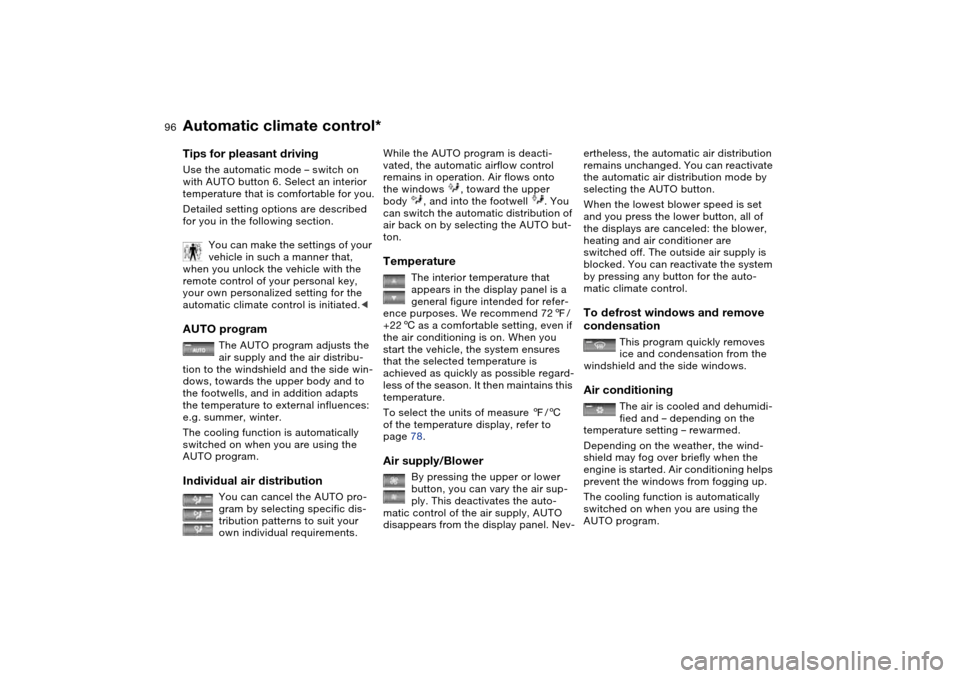
96
Tips for pleasant drivingUse the automatic mode – switch on
with AUTO button 6. Select an interior
temperature that is comfortable for you.
Detailed setting options are described
for you in the following section.
You can make the settings of your
vehicle in such a manner that,
when you unlock the vehicle with the
remote control of your personal key,
your own personalized setting for the
automatic climate control is initiated.
air supply and the air distribu-
tion to the windshield and the side win-
dows, towards the upper body and to
the footwells, and in addition adapts
the temperature to external influences:
e.g. summer, winter.
The cooling function is automatically
switched on when you are using the
AUTO program.
Individual air distribution
You can cancel the AUTO pro-
gram by selecting specific dis-
tribution patterns to suit your
own individual requirements.
While the AUTO program is deacti-
vated, the automatic airflow control
remains in operation. Air flows onto
the windows , toward the upper
body , and into the footwell . You
can switch the automatic distribution of
air back on by selecting the AUTO but-
ton.Temperature
The interior temperature that
appears in the display panel is a
general figure intended for refer-
ence purposes. We recommend 727/
+226 as a comfortable setting, even if
the air conditioning is on. When you
start the vehicle, the system ensures
that the selected temperature is
achieved as quickly as possible regard-
less of the season. It then maintains this
temperature.
To select the units of measure 7/6
of the temperature display, refer to
page 78.
Air supply/Blower
By pressing the upper or lower
button, you can vary the air sup-
ply. This deactivates the auto-
matic control of the air supply, AUTO
disappears from the display panel. Nev-
ertheless, the automatic air distribution
remains unchanged. You can reactivate
the automatic air distribution mode by
selecting the AUTO button.
When the lowest blower speed is set
and you press the lower button, all of
the displays are canceled: the blower,
heating and air conditioner are
switched off. The outside air supply is
blocked. You can reactivate the system
by pressing any button for the auto-
matic climate control.To defrost windows and remove
condensation
This program quickly removes
ice and condensation from the
windshield and the side windows.
Air conditioning
The air is cooled and dehumidi-
fied and – depending on the
temperature setting – rewarmed.
Depending on the weather, the wind-
shield may fog over briefly when the
engine is started. Air conditioning helps
prevent the windows from fogging up.
The cooling function is automatically
switched on when you are using the
AUTO program.
Automatic climate control*
Page 106 of 174

106
Cargo loading
Avoid overloading the vehicle so
that the permitted load on the tires
is not exceeded. Overloading can lead
to overheating and internal tire damage.
The ultimate result can assume the
form of a sudden air loss.<
Determining the maximum load1. Locate the following statement on
your vehicle‘s placard*:
The combined weight of occu-
pants and cargo should never
exceed XXX kg or YYY lbs., as this
could otherwise result in damage to the
vehicle or unstable driving conditions.<
2. Determine the combined weight of
the driver and passengers that will be
riding in your vehicle
3. Subtract the combined weight of the
driver and passengers from
XXX kilograms or YYY pounds
4. The resulting figure equals the avail-
able amount of cargo and luggage
load capacity.
For example, if the XXX amount
equals 1,400 lbs. and there will be
five 150 lbs. passengers in your vehi-
cle, the amount of available cargo
and luggage load capacity is
650 lbs.:
1,400 lbs. minus 750 lbs. = 650 lbs.
5. Determine the combined weight of
luggage and cargo being loaded on
the vehicle. That weight may not
safely exceed the available cargo
and luggage load capacity calculated
in Step 4
6. If your vehicle will be towing a trailer,
load from your trailer will be trans-
fered to your vehicle. Consult the
manual for transporting a trailer to
determine how this may reduce the
available cargo and luggage load
capacity of your vehicle.
Page 114 of 174
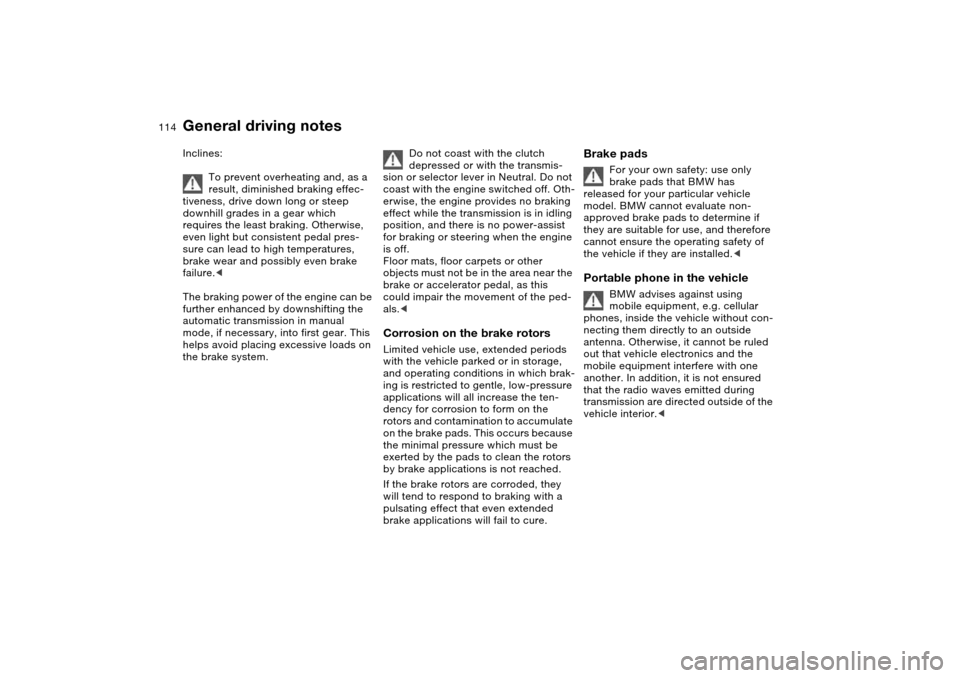
114
Inclines:
To prevent overheating and, as a
result, diminished braking effec-
tiveness, drive down long or steep
downhill grades in a gear which
requires the least braking. Otherwise,
even light but consistent pedal pres-
sure can lead to high temperatures,
brake wear and possibly even brake
failure.<
The braking power of the engine can be
further enhanced by downshifting the
automatic transmission in manual
mode, if necessary, into first gear. This
helps avoid placing excessive loads on
the brake system.
Do not coast with the clutch
depressed or with the transmis-
sion or selector lever in Neutral. Do not
coast with the engine switched off. Oth-
erwise, the engine provides no braking
effect while the transmission is in idling
position, and there is no power-assist
for braking or steering when the engine
is off.
Floor mats, floor carpets or other
objects must not be in the area near the
brake or accelerator pedal, as this
could impair the movement of the ped-
als.<
Corrosion on the brake rotorsLimited vehicle use, extended periods
with the vehicle parked or in storage,
and operating conditions in which brak-
ing is restricted to gentle, low-pressure
applications will all increase the ten-
dency for corrosion to form on the
rotors and contamination to accumulate
on the brake pads. This occurs because
the minimal pressure which must be
exerted by the pads to clean the rotors
by brake applications is not reached.
If the brake rotors are corroded, they
will tend to respond to braking with a
pulsating effect that even extended
brake applications will fail to cure.
Brake pads
For your own safety: use only
brake pads that BMW has
released for your particular vehicle
model. BMW cannot evaluate non-
approved brake pads to determine if
they are suitable for use, and therefore
cannot ensure the operating safety of
the vehicle if they are installed.<
Portable phone in the vehicle
BMW advises against using
mobile equipment, e.g. cellular
phones, inside the vehicle without con-
necting them directly to an outside
antenna. Otherwise, it cannot be ruled
out that vehicle electronics and the
mobile equipment interfere with one
another. In addition, it is not ensured
that the radio waves emitted during
transmission are directed outside of the
vehicle interior.<
General driving notes
Page 164 of 174
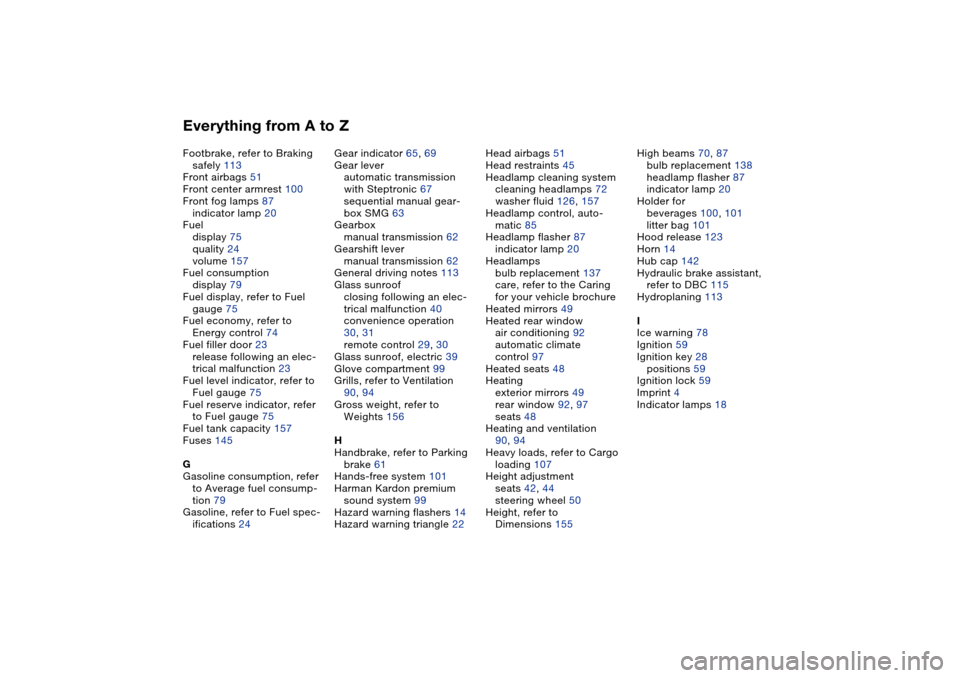
Everything from A to ZFootbrake, refer to Braking
safely 113
Front airbags 51
Front center armrest 100
Front fog lamps 87
indicator lamp 20
Fuel
display 75
quality 24
volume 157
Fuel consumption
display 79
Fuel display, refer to Fuel
gauge 75
Fuel economy, refer to
Energy control 74
Fuel filler door 23
release following an elec-
trical malfunction 23
Fuel level indicator, refer to
Fuel gauge 75
Fuel reserve indicator, refer
to Fuel gauge 75
Fuel tank capacity 157
Fuses 145
G
Gasoline consumption, refer
to Average fuel consump-
tion 79
Gasoline, refer to Fuel spec-
ifications 24Gear indicator 65, 69
Gear lever
automatic transmission
with Steptronic 67
sequential manual gear-
box SMG 63
Gearbox
manual transmission 62
Gearshift lever
manual transmission 62
General driving notes 113
Glass sunroof
closing following an elec-
trical malfunction 40
convenience operation
30, 31
remote control 29, 30
Glass sunroof, electric 39
Glove compartment 99
Grills, refer to Ventilation
90, 94
Gross weight, refer to
Weights 156
H
Handbrake, refer to Parking
brake 61
Hands-free system 101
Harman Kardon premium
sound system 99
Hazard warning flashers 14
Hazard warning triangle 22Head airbags 51
Head restraints 45
Headlamp cleaning system
cleaning headlamps 72
washer fluid 126, 157
Headlamp control, auto-
matic 85
Headlamp flasher 87
indicator lamp 20
Headlamps
bulb replacement 137
care, refer to the Caring
for your vehicle brochure
Heated mirrors 49
Heated rear window
air conditioning 92
automatic climate
control 97
Heated seats 48
Heating
exterior mirrors 49
rear window 92, 97
seats 48
Heating and ventilation
90, 94
Heavy loads, refer to Cargo
loading 107
Height adjustment
seats 42, 44
steering wheel 50
Height, refer to
Dimensions 155High beams 70, 87
bulb replacement 138
headlamp flasher 87
indicator lamp 20
Holder for
beverages 100, 101
litter bag 101
Hood release 123
Horn 14
Hub cap 142
Hydraulic brake assistant,
refer to DBC 115
Hydroplaning 113
I
Ice warning 78
Ignition 59
Ignition key 28
positions 59
Ignition lock 59
Imprint 4
Indicator lamps 18
Page 167 of 174
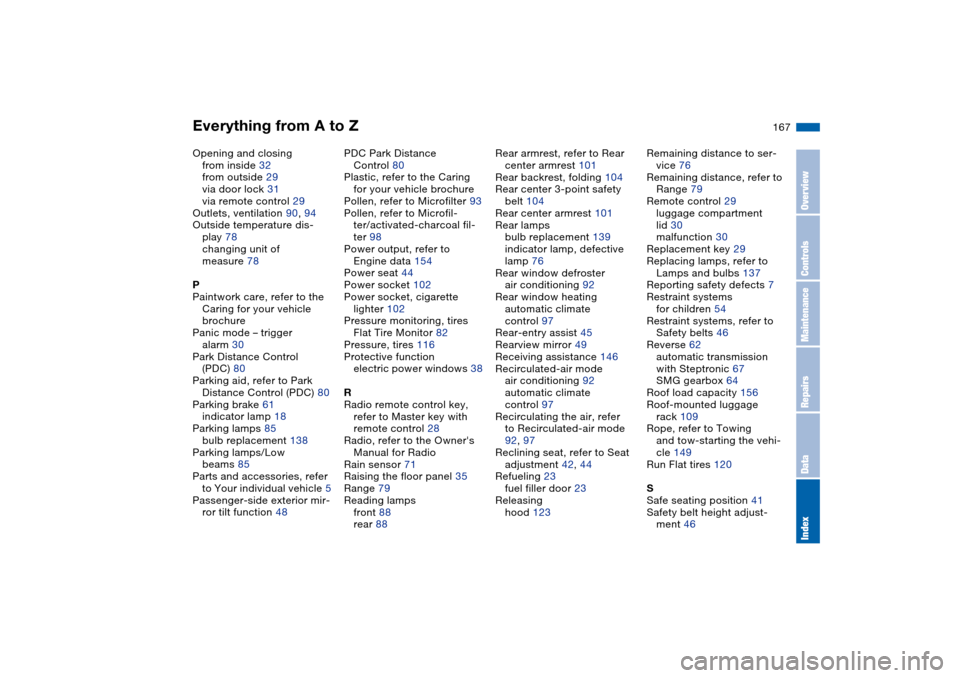
Everything from A to Z
167
Opening and closing
from inside 32
from outside 29
via door lock 31
via remote control 29
Outlets, ventilation 90, 94
Outside temperature dis-
play 78
changing unit of
measure 78
P
Paintwork care, refer to the
Caring for your vehicle
brochure
Panic mode – trigger
alarm 30
Park Distance Control
(PDC) 80
Parking aid, refer to Park
Distance Control (PDC) 80
Parking brake 61
indicator lamp 18
Parking lamps 85
bulb replacement 138
Parking lamps/Low
beams 85
Parts and accessories, refer
to Your individual vehicle 5
Passenger-side exterior mir-
ror tilt function 48PDC Park Distance
Control 80
Plastic, refer to the Caring
for your vehicle brochure
Pollen, refer to Microfilter 93
Pollen, refer to Microfil-
ter/activated-charcoal fil-
ter 98
Power output, refer to
Engine data 154
Power seat 44
Power socket 102
Power socket, cigarette
lighter 102
Pressure monitoring, tires
Flat Tire Monitor 82
Pressure, tires 116
Protective function
electric power windows 38
R
Radio remote control key,
refer to Master key with
remote control 28
Radio, refer to the Owner's
Manual for Radio
Rain sensor 71
Raising the floor panel 35
Range 79
Reading lamps
front 88
rear 88Rear armrest, refer to Rear
center armrest 101
Rear backrest, folding 104
Rear center 3-point safety
belt 104
Rear center armrest 101
Rear lamps
bulb replacement 139
indicator lamp, defective
lamp 76
Rear window defroster
air conditioning 92
Rear window heating
automatic climate
control 97
Rear-entry assist 45
Rearview mirror 49
Receiving assistance 146
Recirculated-air mode
air conditioning 92
automatic climate
control 97
Recirculating the air, refer
to Recirculated-air mode
92, 97
Reclining seat, refer to Seat
adjustment 42, 44
Refueling 23
fuel filler door 23
Releasing
hood 123Remaining distance to ser-
vice 76
Remaining distance, refer to
Range 79
Remote control 29
luggage compartment
lid 30
malfunction 30
Replacement key 29
Replacing lamps, refer to
Lamps and bulbs 137
Reporting safety defects 7
Restraint systems
for children 54
Restraint systems, refer to
Safety belts 46
Reverse 62
automatic transmission
with Steptronic 67
SMG gearbox 64
Roof load capacity 156
Roof-mounted luggage
rack 109
Rope, refer to Towing
and tow-starting the vehi-
cle 149
Run Flat tires 120
S
Safe seating position 41
Safety belt height adjust-
ment 46
OverviewControlsMaintenanceRepairsDataIndex
Page 168 of 174
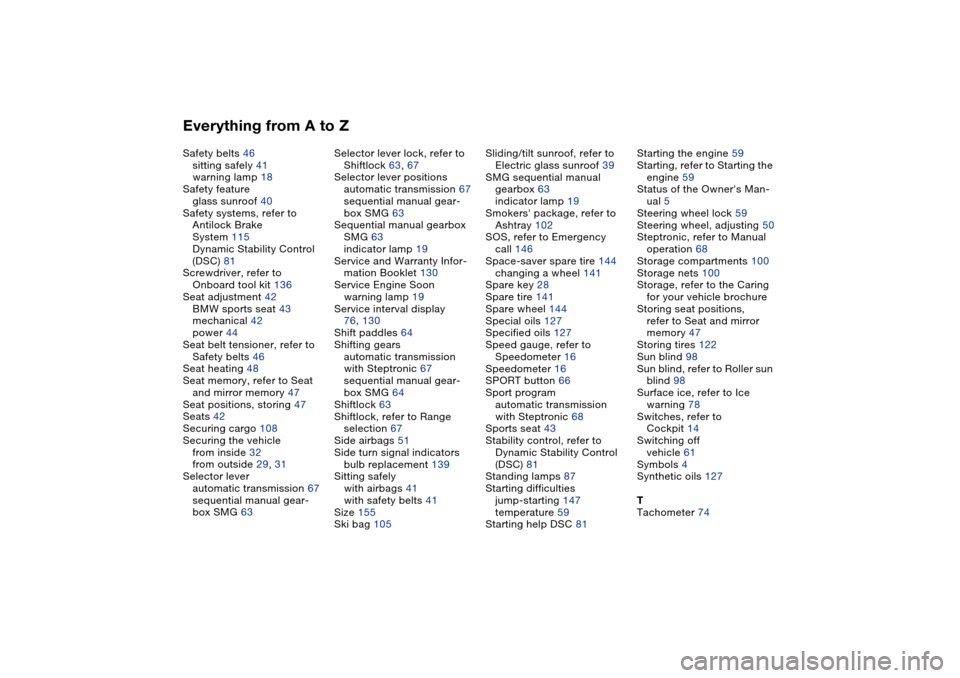
Everything from A to ZSafety belts 46
sitting safely 41
warning lamp 18
Safety feature
glass sunroof 40
Safety systems, refer to
Antilock Brake
System 115
Dynamic Stability Control
(DSC) 81
Screwdriver, refer to
Onboard tool kit 136
Seat adjustment 42
BMW sports seat 43
mechanical 42
power 44
Seat belt tensioner, refer to
Safety belts 46
Seat heating 48
Seat memory, refer to Seat
and mirror memory 47
Seat positions, storing 47
Seats 42
Securing cargo 108
Securing the vehicle
from inside 32
from outside 29, 31
Selector lever
automatic transmission 67
sequential manual gear-
box SMG 63Selector lever lock, refer to
Shiftlock 63, 67
Selector lever positions
automatic transmission 67
sequential manual gear-
box SMG 63
Sequential manual gearbox
SMG 63
indicator lamp 19
Service and Warranty Infor-
mation Booklet 130
Service Engine Soon
warning lamp 19
Service interval display
76, 130
Shift paddles 64
Shifting gears
automatic transmission
with Steptronic 67
sequential manual gear-
box SMG 64
Shiftlock 63
Shiftlock, refer to Range
selection 67
Side airbags 51
Side turn signal indicators
bulb replacement 139
Sitting safely
with airbags 41
with safety belts 41
Size 155
Ski bag 105Sliding/tilt sunroof, refer to
Electric glass sunroof 39
SMG sequential manual
gearbox 63
indicator lamp 19
Smokers' package, refer to
Ashtray 102
SOS, refer to Emergency
call 146
Space-saver spare tire 144
changing a wheel 141
Spare key 28
Spare tire 141
Spare wheel 144
Special oils 127
Specified oils 127
Speed gauge, refer to
Speedometer 16
Speedometer 16
SPORT button 66
Sport program
automatic transmission
with Steptronic 68
Sports seat 43
Stability control, refer to
Dynamic Stability Control
(DSC) 81
Standing lamps 87
Starting difficulties
jump-starting 147
temperature 59
Starting help DSC 81Starting the engine 59
Starting, refer to Starting the
engine 59
Status of the Owner's Man-
ual 5
Steering wheel lock 59
Steering wheel, adjusting 50
Steptronic, refer to Manual
operation 68
Storage compartments 100
Storage nets 100
Storage, refer to the Caring
for your vehicle brochure
Storing seat positions,
refer to Seat and mirror
memory 47
Storing tires 122
Sun blind 98
Sun blind, refer to Roller sun
blind 98
Surface ice, refer to Ice
warning 78
Switches, refer to
Cockpit 14
Switching off
vehicle 61
Symbols 4
Synthetic oils 127
T
Tachometer 74